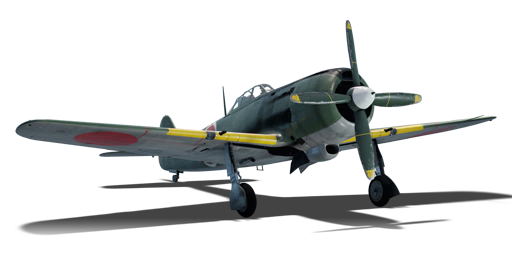

Aviation
Ki-84 Ko
IV
Rank
AB
6.0
RB
5.3
SB
5.0
Battle rating
Japan
Research country
Fighter
Main role
54,000

Research
185,000

Purchase
General information
Flight performance
Max speed
at 6,000 m
692651718669 km/h
Rate of Climb
17.914.222.614.2 m/s
Turn time
19.420.818.620.2 s
Max altitude
13,000 m
Takeoff Run
420 m
Landing
flaps
flaps
Take-off
flaps
flaps
Combat
flaps
flaps
Air
brake
brake
General characteristics
Crew
1 person
Engine
Length
9.7 m
Wingspan
11.2 m
Wing Loading
169 kg/m²
Weight:
Base weight
3.153.243.073.22 t
Fuel in main tanks
0.41 t (51m)
Limits:
Max Speed Limit (IAS)
837 km/h
Mach Number Limit
0.82 M
G limit
≈ -9/13 G
Flap Speed Limit (IAS)
L / T / C
280 / 431 / 470 km/h
Gear Speed Limit (IAS)
270 km/h
Offensive armament
2 × 20 mm Ho-5 cannon
Ammunition
300 rounds
Fire rate
948 shots/min
One-second Burst Mass
1.54 kg
| Belt | Belt filling | Armor penetration (mm) at a distance: | |||||
|---|---|---|---|---|---|---|---|
| 10 m | 100 m | 500 m | 1000 m | 1500 m | 2000 m | ||
| HEF-I/P/AP-T | 27 | 25 | 17 | 10 | 6 | 4 | |
| HEF-I/HEF-I/AP-T | 27 | 25 | 17 | 10 | 6 | 4 | |
| AP-T/AP-T/HEF-I | 27 | 25 | 17 | 10 | 6 | 4 | |
| AP-T | 27 | 25 | 17 | 10 | 6 | 4 | |
| HEF-I/HEF-I/HEF-I/P | 16 | 13 | 8 | 6 | 0 | 0 | |
2 × 12.7 mm Ho-103 machine gun
Ammunition
700 rounds
Fire rate
900 shots/min
One-second Burst Mass
0.53 kg
| Belt | Belt filling | Armor penetration (mm) at a distance: | |||||
|---|---|---|---|---|---|---|---|
| 10 m | 100 m | 500 m | 1000 m | 1500 m | 2000 m | ||
| AP-T/AP/HEF-I | 21 | 19 | 13 | 7 | 4 | 3 | |
| AP-T/HEF-I/AP/HEF-I | 21 | 19 | 13 | 7 | 4 | 3 | |
| AP-T/HEF-I/HEF-I/HEF-I | 21 | 19 | 13 | 7 | 4 | 3 | |
| AP-T/AP/AP-T | 21 | 19 | 13 | 7 | 4 | 3 | |
| AP/HEF-I/HEF-I/HEF-I | 21 | 19 | 13 | 7 | 4 | 3 | |
Suspended armament
Setup 1
2 × 50 kg Army Type 94 GPHE bomb
Setup 2
2 × 100 kg Army Type 94 GPHE bomb
Setup 3
2 × 250 kg Army Type 92 GPHE bomb
Economy
Repair cost
Basic → Reference
AB
2,590 → 3,294 

RB
5,861 → 7,455 

SB
8,203 → 10,434 

Crew training
52,000 

Experts
185,000 

Aces
940 

Research Aces
480,000 

Reward multiplier
AB / RB / SB
100 / 210 / 440 % 

166 % 

Total cost of modifications
46,900 

85,500 

Talisman cost
1,500 

Research order:
Flight performance | |
|---|---|
Survivability |
|---|
Weaponry | |
|---|---|
Rating by players
You must play more than 3 battles for the last week and more than 10 battles in a vehicle to rate it.
Like:
36
Flight performance:
Not enough ratings
Survivability:
Not enough ratings
Aerial combat:
Not enough ratings
Ground attack:
Not enough ratings
Balance:
Not enough ratings
Tips & Tricks
This space is currently empty
Do you know any interesting vehicle features?
Loading...
No articles about this vehicle yet
Become the first author and get rewards!
Write a guide, tell about interesting historical facts, make a tutorial or simply an interesting post.
No more content